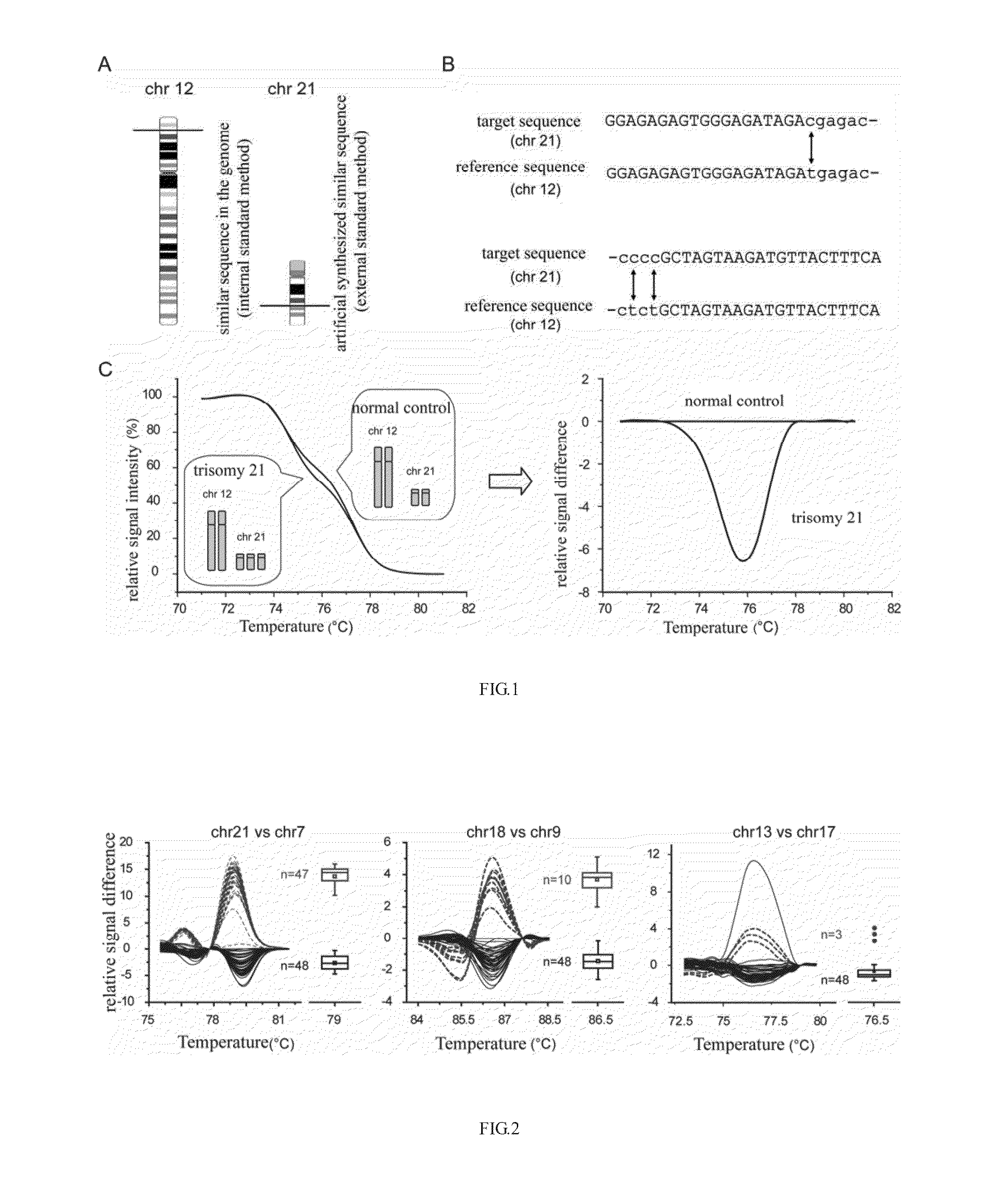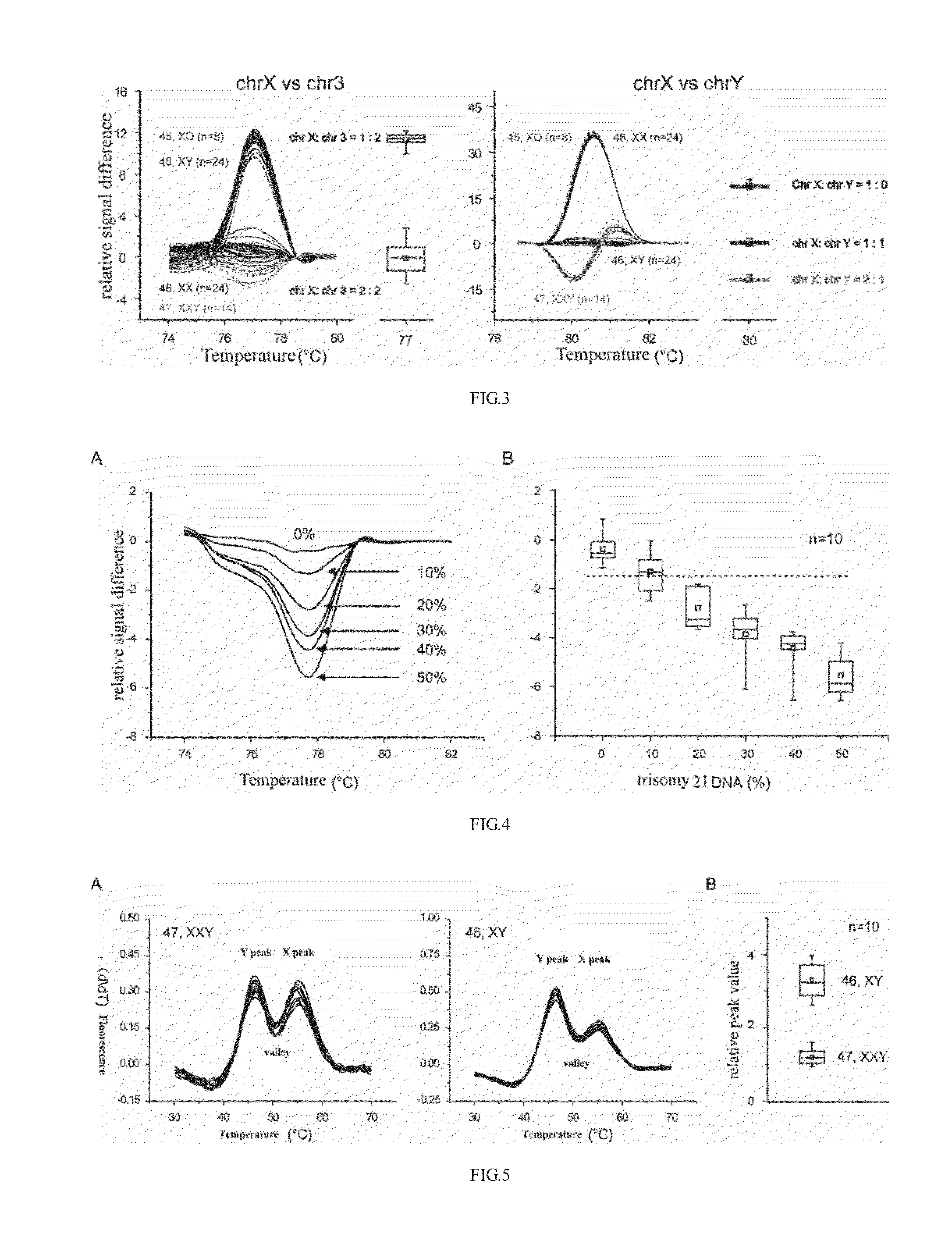Method for the detection of copy number variations
a technology of copy number and variation, applied in the field of copy number variation detection, can solve the problems of abnormal phenotype, high prevalence of inherited diseases, and uncurable diseases, and achieve the effect of convenient setup
- Summary
- Abstract
- Description
- Claims
- Application Information
AI Technical Summary
Benefits of technology
Problems solved by technology
Method used
Image
Examples
first embodiment
[0044]The Detection of human autosome aneuploidies by melting analysis with saturation dye.
[0045]Trisomies 13, 18, and 21 are common human autosome aneuploidies. Trisomy 21 is also called Down's syndrome which prevalence is 1 / 700 in live birth. Down's syndrome has varies inherited abnormalities including learning disorder, disturbance of intelligence, deformity or other highly malformations. The disease can not be cured, and the prenatal diagnosis is an effective approach for disease control. The prevalence of trisomy 18 and 13 are 1 / 5000 and 1 / 25000, respectively. These aneuploidies also cause severe malformation and physical disability. Therefore, the prenatal diagnosis of these syndromes is also important.
[0046]I. Materials
[0047]1. Instruments:
[0048]Real-time PCR system, transferpettor, centrifuge.
[0049]2. Primer design:
[0050]The present invention selected a similar reference sequence on chromosome 7 according to the target sequence on chromosome 21; selected a similar reference...
second embodiment
[0072]The Detection of human sex chromosome aneuploidies by melting analysis with saturation dye.
[0073]Except for trisomy 21, sex chromosome aneuploids such as 45, X and 47, XXY, are most prevalent in live birth. The prevalence of 45,X in female is approximately 1 / 2000, while the prevalence of 47,XXY in male is approximately 1 / 500. sex chromosome aneuploidies effects on the phenotypic development, especially in reproductive system. However, Hormone therapy can be used to improve the quality of life if sex chromosome aneuploidies are diagnosed early. Therefore, early and rapid diagnosis of sex chromosome aneuploidies is clinically important.
[0074]I. The materials
[0075]1. Instruments:
[0076]real-time fluorescent PCR system, pipettor, centrifuge.
[0077]2. Primer design:
[0078]The present invention selected a pair of similar sequence located on chromosome 3 and X chromosome, and a pair of similar sequence located on X chromosome and Y chromosome. Two corresponding pairs of primers were li...
third embodiment
[0100]The Detection of trisomy 21 DNA in different normal DNA backgrounds.
[0101]Mosaicism is an individual with two or more than two kinds of genotype cells. According to different proportions of abnormal cells, the mosaicism exhibites a series of different degrees of symptom. In general, bigger the proportion of abnormal cells is, worse the symptom is.
[0102]Non-invasive prenatal diagnosis refers to detecting cell-free fetal DNA or RNA in the maternal plasma to obtain the genetic information of a fetus, thus avoiding the risk of miscarriage in invasive sampling. Studies have revealed that the fetal DNA fraction in first trimester is approximately 10%.
[0103]To describe the capability of the present invention in mosaicism detection and non-invasive prenatal diagnosis, we tested different ratios of trisomy 21 DNA samples and unaffected control samples.
[0104]I. The materials
[0105]1. Instruments:
[0106]real-time fluorescent PCR system, pipettor, centrifuge.
[0107]2. Primer design:
[0108]Th...
PUM
| Property | Measurement | Unit |
|---|---|---|
| melting curve analysis | aaaaa | aaaaa |
| temperature | aaaaa | aaaaa |
| capillary electrophoresis | aaaaa | aaaaa |
Abstract
Description
Claims
Application Information
 Login to View More
Login to View More - R&D
- Intellectual Property
- Life Sciences
- Materials
- Tech Scout
- Unparalleled Data Quality
- Higher Quality Content
- 60% Fewer Hallucinations
Browse by: Latest US Patents, China's latest patents, Technical Efficacy Thesaurus, Application Domain, Technology Topic, Popular Technical Reports.
© 2025 PatSnap. All rights reserved.Legal|Privacy policy|Modern Slavery Act Transparency Statement|Sitemap|About US| Contact US: help@patsnap.com


